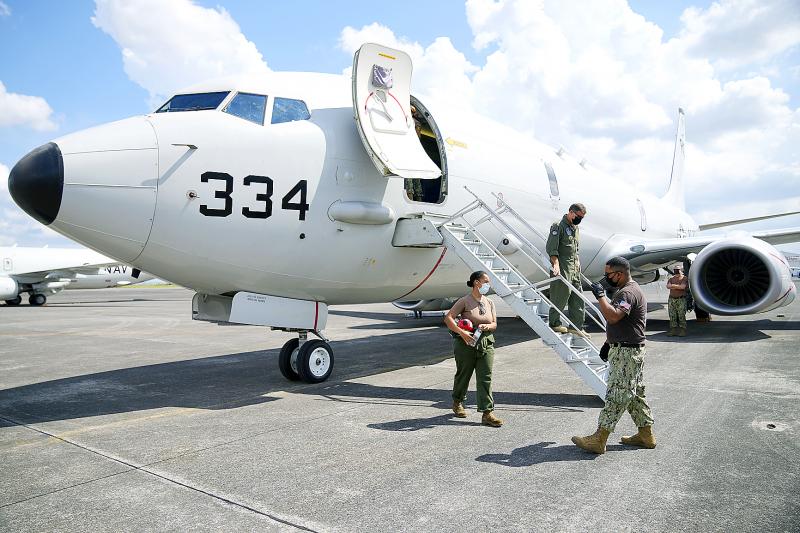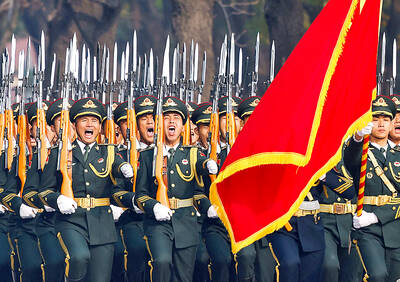The passage of a US Navy P-8A Poseidon aircraft through the Taiwan Strait on Friday was aimed at countering China’s claims to the waterway and its “systematic expansion” in the region, local military experts said.
The flight of the maritime patrol reconnaissance plane was a response to China’s assertion that the Taiwan Strait is not international waters, Institute for National Defense and Security Research analyst Su Tzu-yun (蘇紫雲) said.
It was also aimed at countering the expansion of China’s military presence in the region, for example its aircraft incursions into Taiwan’s air defense identification zone (ADIZ) and warships sailing through waters claimed by China and other countries in the South China Sea, Su said.

Photo: AP
Chinese and Russian naval vessels were also navigating Japan’s territorial waters, he added.
The US aircraft’s transit came after 29 Chinese military planes entered Taiwan’s ADIZ on Tuesday, the third-highest single-day total this year, and after Chinese Ministry of Foreign Affairs spokesman Wang Wenbin (汪文斌) told a news conference that the Taiwan Strait fell within China’s territorial waters.
The US Indo-Pacific Command said in a statement that the transit “demonstrates the United States’ commitment to a free and open Indo-Pacific,” CNN reported on Friday.
“The United States will continue to fly, sail and operate anywhere international law allows, including within the Taiwan Strait,” the statement read. “By operating within the Taiwan Strait in accordance with international law, the United States upholds the navigational rights and freedoms of all nations.”
The US’ rare move was apparently meant to counteract the harassment of Japan by Chinese and Russian ships, Institute for National Defense and Security Research analyst Shu Hsiao-huang (舒孝煌) said.
The Ministry of National Defense said that it has a full grasp of China’s military activity and has contingency measures in place to safeguard national security.
People’s Liberation Army Eastern Theater Command spokesman Colonel Shi Yi (施毅) criticized the US for “endangering the peace and stability in the Taiwan Strait” by flying the aircraft and publicizing the move.
The Eastern Theater Command had organized air and ground forces to monitor the US aircraft’s entire operation, he said.
China has stepped up its military activities near Taiwan in the past few years in response to what it sees as closer ties between Washington and Taipei.
The Democratic Progressive Party has accused Beijing of continuing to use military, diplomatic and economic means to intimidate Taiwan and neighboring countries in the Indo-Pacific region, heightening regional tensions and making no efforts to break the deadlock between the two sides.

The Ministry of Foreign Affairs (MOFA) yesterday said it is closely monitoring developments in Venezuela, and would continue to cooperate with democratic allies and work together for regional and global security, stability, and prosperity. The remarks came after the US on Saturday launched a series of airstrikes in Venezuela and kidnapped Venezuelan President Nicolas Maduro, who was later flown to New York along with his wife. The pair face US charges related to drug trafficking and alleged cooperation with gangs designated as terrorist organizations. Maduro has denied the allegations. The ministry said that it is closely monitoring the political and economic situation

Conflict with Taiwan could leave China with “massive economic disruption, catastrophic military losses, significant social unrest, and devastating sanctions,” a US think tank said in a report released on Monday. The German Marshall Fund released a report titled If China Attacks Taiwan: The Consequences for China of “Minor Conflict” and “Major War” Scenarios. The report details the “massive” economic, military, social and international costs to China in the event of a minor conflict or major war with Taiwan, estimating that the Chinese People’s Liberation Army (PLA) could sustain losses of more than half of its active-duty ground forces, including 100,000 troops. Understanding Chinese

UNRELENTING: China attempted cyberattacks on Taiwan’s critical infrastructure 2.63 million times per day last year, up from 1.23 million in 2023, the NSB said China’s cyberarmy has long engaged in cyberattacks against Taiwan’s critical infrastructure, employing diverse and evolving tactics, the National Security Bureau (NSB) said yesterday, adding that cyberattacks on critical energy infrastructure last year increased 10-fold compared with the previous year. The NSB yesterday released a report titled Analysis on China’s Cyber Threats to Taiwan’s Critical Infrastructure in 2025, outlining the number of cyberattacks, major tactics and hacker groups. Taiwan’s national intelligence community identified a large number of cybersecurity incidents last year, the bureau said in a statement. China’s cyberarmy last year launched an average of 2.63 million intrusion attempts per day targeting Taiwan’s critical

‘SLICING METHOD’: In the event of a blockade, the China Coast Guard would intercept Taiwanese ships while its navy would seek to deter foreign intervention China’s military drills around Taiwan this week signaled potential strategies to cut the nation off from energy supplies and foreign military assistance, a US think tank report said. The Chinese People’s Liberation Army (PLA) conducted what it called “Justice Mission 2025” exercises from Monday to Tuesday in five maritime zones and airspace around Taiwan, calling them a warning to “Taiwanese independence” forces. In a report released on Wednesday, the Institute for the Study of War said the exercises effectively simulated blocking shipping routes to major port cities, including Kaohsiung, Keelung and Hualien. Taiwan would be highly vulnerable under such a blockade, because it